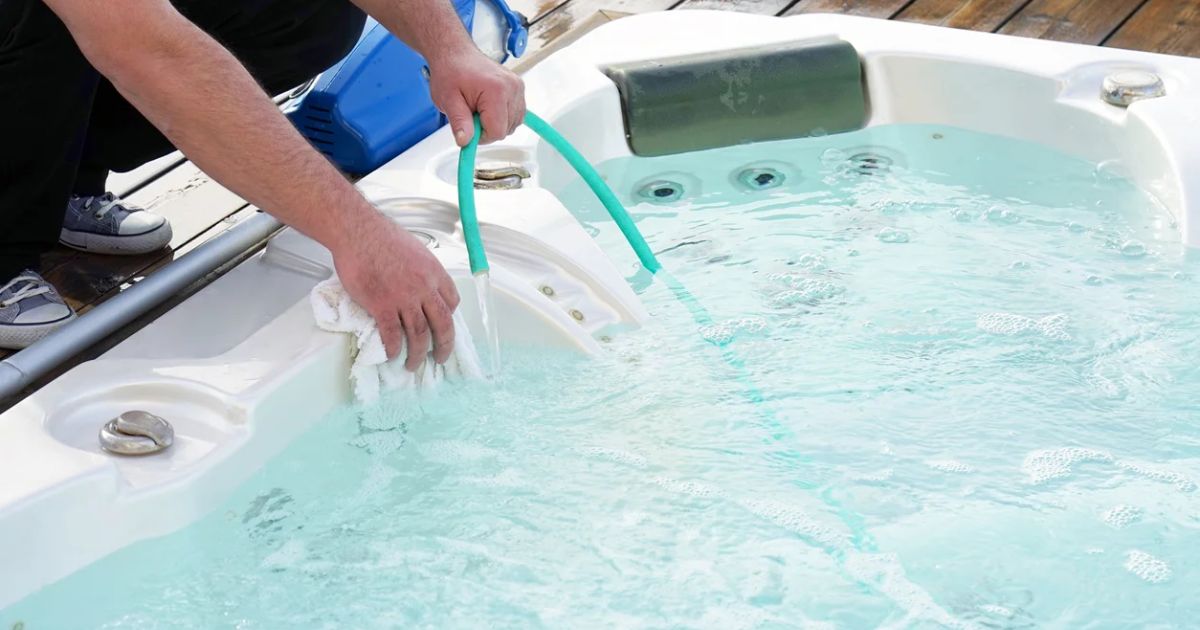Draining a hot tub involves several steps to ensure a safe and efficient process. Begin by turning off the power to the hot tub and preparing the area for drainage. Locate the drain valve or outlet, usually found near the bottom of the tub. Attach a garden hose to the drain outlet securely.
Once prepared, open the drain valve to start emptying the hot tub. Allow the water to flow through the hose to a suitable drainage area. Depending on the tub’s size, this process may take some time.
After draining, take the opportunity to clean the interior surfaces of the hot tub thoroughly. Inspect and clean the filters to maintain optimal functionality. Finally, refill the hot tub and restart it according to the manufacturer’s instructions.
Remember, safety precautions are crucial—be cautious when working with electrical equipment and draining hot water. Following these steps ensures a well-maintained hot tub for continued enjoyment.
How To Drain A Hot Tub Using The Drain Spigot?
Draining a hot tub using the drain spigot involves these steps:
Prepare the Area
Preparing the area involves ensuring the hot tub’s electrical power is off. Position a garden hose close to the drain spigot for efficient water flow. Confirm the hose’s secure attachment to the spigot. Additionally, arrange the hose to direct the draining water away from the hot tub area to prevent flooding or damage. This step ensures a safe and organized setup before initiating the draining process.
Locate the Drain Spigot
The drain spigot on a hot tub is typically positioned near the base of the tub’s exterior. It’s commonly found along the bottom, often adjacent to the side paneling or underneath the hot tub. Identifying and accessing this spigot is crucial for draining the tub efficiently. Ensuring its proper location and connection to a hose allows for the smooth flow of water during the draining process, preventing water accumulation in the tub.
Open the Spigot
Opening the spigot on a hot tub involves turning it counterclockwise to allow water flow. This action initiates the drainage process, enabling water to exit through the spigot and the attached hose. Careful manipulation ensures a steady flow and directs the water away from the tub area. Monitoring the spigot’s position and adjusting the hose assists in controlling the drainage and prevents potential overflow during the draining process.
Let it Drain
Allowing the hot tub to drain involves letting the water flow steadily out through the spigot or drainage outlet. It’s essential to monitor the draining process to ensure it progresses smoothly without overflow. Adjusting the hose’s position or momentarily halting the drainage can manage water levels effectively. Once the draining is complete, close the spigot securely to prevent any residual water from escaping.
Monitor Water Level
Monitoring the water level during drainage is crucial. Keep a close eye on the draining process to prevent overflow or potential damage. Adjust the hose positioning or temporarily halt the draining if needed to maintain control over the water level. This careful monitoring ensures a smooth and safe drainage process, allowing for efficient water removal without causing any unwanted spillage or mess in the surrounding area.
Close the Spigot
Closing the spigot after draining the hot tub is crucial. Turn the spigot clockwise firmly to prevent any water leakage or residual drainage. Ensuring a secure closure prevents potential water wastage and keeps the tub area dry. Confirm the spigot is tightly closed before disconnecting the hose to avoid any inadvertent leaks or drips. This step completes the draining process, allowing for subsequent cleaning and maintenance tasks to be performed efficiently.
Disconnect the Hose
After draining your hot tub using the spigot, disconnect the hose carefully. Ensure the spigot is securely closed to prevent any residual water from escaping. Coil the hose neatly and store it in a dry area. Inspect the hot tub for any remaining water and wipe it dry if necessary. This step ensures the hose is properly stored and the tub is ready for cleaning or maintenance before refilling.
Post-Drain Maintenance
Post-drain maintenance of a hot tub involves crucial steps for cleanliness and upkeep. After draining, clean the tub surfaces thoroughly, including filters and jets, using mild cleaners. Inspect for any debris or buildup and address it promptly. Consider applying protective coatings or treatments to extend the tub’s lifespan. Lastly, perform any required maintenance tasks, such as checking and replacing worn parts, ensuring the tub is ready for future use.
How To Drain A Hot Tub Using A Submersible Pump?
Draining a hot tub using a submersible pump is an efficient method:
Preparation
Preparation is key when draining a hot tub. Ensure the tub’s power is off to prevent any electrical hazards. Position the necessary equipment, such as a submersible pump or drainage hose, ensuring they’re ready for use. Plan for a suitable drainage area where the water can safely flow. Prioritize safety by double-checking all connections and ensuring the pump is correctly submerged before starting the drainage process.
Attach Hose
To drain a hot tub using a submersible pump, attach a drainage hose securely to the pump’s outlet. Ensure a tight connection to prevent leaks and direct the hose toward a suitable drainage area. The hose should be long enough to reach the desired location for water disposal, ensuring efficient drainage without causing any water accumulation near the hot tub area.
Power Up
Powering up” refers to activating the submersible pump by connecting it to a suitable power source. Once plugged in, the pump starts drawing water from the hot tub, facilitating the draining process. This step involves switching the pump on to initiate the suction and expulsion of water through the connected drainage hose. Monitoring the pump during this phase ensures a steady and efficient removal of water from the tub.
Monitor Progress
While draining a hot tub with a submersible pump, regularly monitor the water level and the pump’s performance. Adjust the hose to ensure proper water flow and direction away from the tub area. Keep an eye on the draining process, ensuring the pump functions smoothly and the water drains efficiently. This oversight ensures a successful and complete drainage, preventing any potential overflow or issues during the process.
Complete Drainage
Achieving complete drainage in a hot tub is crucial for maintenance. Whether using a drain spigot or a submersible pump, ensure the tub is entirely emptied. Monitor the process, adjusting hoses or equipment as needed to prevent water pooling. Complete drainage prevents residual water from stagnating, reducing the risk of bacterial growth or damage to the tub’s components. It’s vital for a thorough cleaning and ensures the hot tub is ready for subsequent use or maintenance.
Clean and Store
After draining, clean the hot tub thoroughly using appropriate cleaners to eliminate residues. Wipe surfaces and ensure dryness to prevent mold or mildew growth. Store any removable accessories properly, ensuring they are dry before storage. For equipment like pumps or hoses, clean them meticulously, allowing complete drying before storing in a clean, dry area. Proper cleaning and storage practices maintain the hot tub’s condition and equipment, ensuring readiness for future use.
This method offers a quick and effective way to remove water from the hot tub, requiring minimal effort and facilitating thorough drainage.
How To Drain A Hot Tub Without A Pump?
Draining a hot tub sans a pump involves resourcefulness and a bit of physical effort. One method involves the siphoning technique. Begin by gathering a long garden hose and a pair of pliers. Submerge one end of the hose completely into the hot tub and fill it with water by turning on a tap. Once filled, quickly shut off the tap and pinch the hose closed to retain the water. Move the hose downhill, aiming it towards a drain, and release the pinch, initiating the siphoning process. Monitor the flow, adjusting the hose if needed, until the tub is nearly empty.
Alternatively, the “bucket brigade” method entails using large containers to manually transfer water. Armed with multiple buckets, scoop water from the hot tub and transport it to a drain or desired location. This technique requires physical labor but can be effective, especially if no other tools are available.
For those with a wet/dry vacuum or a submersible pump, these tools can simplify the process. Simply submerge the pump in the hot tub and use the hose attachment to drain water into a suitable location.
Whichever method chosen, careful consideration of safety, such as avoiding electrical hazards and proper water disposal, is vital. While manual draining may demand time and effort, it remains a viable solution when specialized equipment isn’t on hand.
What Is The Easiest Way To Drain A Hot Tub?
The easiest way to drain a hot tub often involves using a dedicated drain valve or a built-in draining system, if your hot tub has one. Here are steps for the easiest drainage method:
Using a Drain Valve or Built-in System
Locate the Drain Valve: Check your hot tub for a drain valve. It’s typically located at the bottom of the tub or on the exterior near the bottom.
Connect a Hose (if applicable): If the drain valve has a hose connection, attach a garden hose. This directs the water away to a desired location, like a drain or a suitable area for water disposal.
Open the Valve: Turn the drain valve counterclockwise to open it. If it’s connected to a hose, ensure the hose is properly set up for water flow.
Allow Draining: Let gravity do the work as the water drains out through the valve. Monitor the process until the hot tub is empty.
Close the Valve: Once the tub is empty, close the drain valve securely by turning it clockwise.
Considerations
- Power Source: Some hot tubs have pumps specifically designed for drainage. These can be the easiest method, requiring minimal effort. Check if your hot tub has this feature.
- Drainage Location: Ensure the water drains to an appropriate location, avoiding areas susceptible to flooding or causing damage.
Using the dedicated drain valve or built-in draining system is often the simplest and most convenient way to empty a hot tub, as it requires minimal manual effort and utilizes the tub’s designed mechanisms for drainage.
Can A Hot Tub Drain On Its Own?
A hot tub typically does not drain on its own without some form of manual intervention or a deliberate action to initiate the drainage process. Hot tubs are designed to retain water, and their drainage systems usually require specific steps to empty the tub.
Some newer hot tub models may have features like an automatic drain function that can be programmed or activated remotely through a control panel or app. However, this is not a standard feature in most hot tubs.
In general, without human intervention or specific settings being activated, a hot tub will not drain on its own. The water remains in the tub until a user manually initiates the drainage process by using a drain valve, a built-in draining system, or a pump designed for draining.
Regular maintenance involving draining and refilling the hot tub is crucial for water quality, cleanliness, and overall system health. Therefore, owners typically need to take deliberate steps to drain the hot tub as part of routine maintenance or when needed for repairs or relocation.
Draining the Water Safely
Draining the water from a hot tub safely is crucial to maintain both the tub’s integrity and the surrounding environment. Begin by turning off the power supply to the hot tub and ensuring all electrical connections are safely disconnected to avoid any mishaps. Next, locate the drainage valve or plug, typically found near the bottom of the tub. Attach a hose to facilitate water flow away from the tub, preventing flooding or damage to the area.
Monitor the draining process closely, as a rapid release of water can cause erosion around the tub or lead to unexpected flooding. Regularly check the hose’s placement to guarantee it remains properly directed. Once the tub is empty, take the opportunity to inspect the interior for any debris or buildup, cleaning it thoroughly before refilling. By cautiously managing the drainage process, you safeguard both the hot tub’s components and the surrounding space, ensuring a safe and efficient water removal process.
Reconnecting and Preparing for Refill
After draining your hot tub, the crucial step of reconnecting and preparing for a refill ensures a smooth restart. First, inspect the drain plugs and connections, ensuring they’re secure and free from damage. Reattach any removed components carefully, including filters, to guarantee proper functionality. Take this opportunity to clean or replace the filter if necessary.
Next, check the tub’s interior for any debris or residue left from draining. Wipe down surfaces and sanitize the tub, ensuring a fresh start for the new water. Reconnect the power supply, ensuring that all electrical connections are secure and dry to prevent any hazards.
Before refilling, double-check the water source quality, ensuring it’s suitable for your hot tub. Balance the chemicals to the recommended levels, allowing the water to circulate for optimal mixing. Once everything is in order, start the refill process, monitoring it closely to prevent overflow.
This meticulous approach to reconnecting and preparing for the refill guarantees a clean, safe, and well-maintained hot tub experience.
Tips for Efficient Hot Tub Drainage
Efficient hot tub drainage is essential for maintenance and cleaning. Here are some tips to facilitate a smooth drainage process:
Plan Ahead: Schedule drainage during warmer weather to prevent freezing if you live in a colder climate. Choose a time when you can dedicate enough attention to the process without rushing.
Prepare the Area: Clear the area around the drain outlet to ensure unobstructed water flow. Have a proper drainage route ready to direct the water away from the hot tub location.
Use a Submersible Pump: Invest in a submersible pump for faster drainage. These pumps are efficient and can significantly speed up the process compared to relying solely on the tub’s built-in drain.
Gravity-Assisted Drainage: If using a submersible pump, elevate the pump slightly to enable gravity-assisted drainage, allowing water to flow more easily.
Open Air Valves and Draining Plugs: Ensure all air valves and draining plugs are open to facilitate complete water drainage. Check the manufacturer’s manual for specific instructions on any additional valves that need opening.
Regular Maintenance: Regularly clean the tub’s filters and maintain the water chemistry to prevent clogs and ensure smoother drainage each time.
Monitor the Process: Stay attentive during drainage to prevent overflows. Have towels or a mop handy in case of spills.
By implementing these tips, you can streamline the hot tub drainage process, ensuring efficiency and ease while maintaining your tub effectively.
Troubleshooting Common Drainage Issues
Troubleshooting common drainage issues in a hot tub is essential for maintaining its functionality. One prevalent problem is slow or incomplete drainage. If your tub drains sluggishly, check for clogs in the drain valve or filter. Debris and residue can accumulate, impeding the flow of water. Clearing these obstructions or replacing a worn-out filter can often resolve this issue.
Another common challenge is a leaking drain plug or valve. Inspect these components for any signs of damage, wear, or improper sealing. Tightening or replacing the drain plug’s seal could be a quick fix.
Sometimes, drainage problems stem from a malfunctioning pump or motor. If the pump fails to remove water effectively, it might require professional inspection or repair. Additionally, improper installation or alignment of the drainage system could cause issues. Ensure all components are correctly set up according to the manufacturer’s guidelines. Regular maintenance and periodic checks can preemptively address many drainage concerns, preserving the hot tub’s functionality.
FAQ’s
How long should it take to drain a hot tub?
However, if the drain is not nearby, attach the spigot to a garden hose and then place the other end into the drain, before opening the drain valve. Using this method, most hot tubs/spas will be drained in about one or two hours. There might also be pools of water left depending on the contours of the hot tub.
What causes a hot tub to drain?
Check for a bad seal — While PVC pipes can burst if water freezes in the line over the winter, the most likely culprit of your hot tub’s leak is a bad seal. If you’ve examined the check valve (or valves) and determined it is not the cause of your leak, a corroded pump seal may be to blame.
How often should I drain my hot tub?
Drain your hot tub every 3-4 months. Contaminants like. sweat, body oils and bacteria can build up over time in. your hot tub lines.
Should you drain hot tub in summer?
Some people choose to leave their hot tubs empty in the summer, particularly if they are going away for extended periods of time during the holidays. Leaving your hot tub empty during these months is not issue provided you have a suitable hot tub cover.
Is it OK to clean a hot tub with vinegar?
Diluted white vinegar is great, but you can also use lemon juice, CLR, or other similar acetic solutions to clean and dissolved calcium build-up. You could even use muriatic acid, but be careful. At Royal Spa, we prefer to use acid-based pH down.
Conclusion
In conclusion, effectively draining a hot tub involves a systematic approach to ensure a seamless process and maintain the tub’s longevity. Proper preparation, including disconnecting power sources and addressing potential obstacles like clogs or leaks, is crucial. Thorough cleaning, inspection, and maintenance during drainage help prevent future issues.
Reconnecting the tub and preparing for a refill completes the cycle. Following manufacturer guidelines and implementing regular checks and maintenance routines are key to preserving the hot tub’s functionality. By adhering to these steps and exercising caution, one can efficiently drain a hot tub while safeguarding its optimal performance for prolonged enjoyment.








